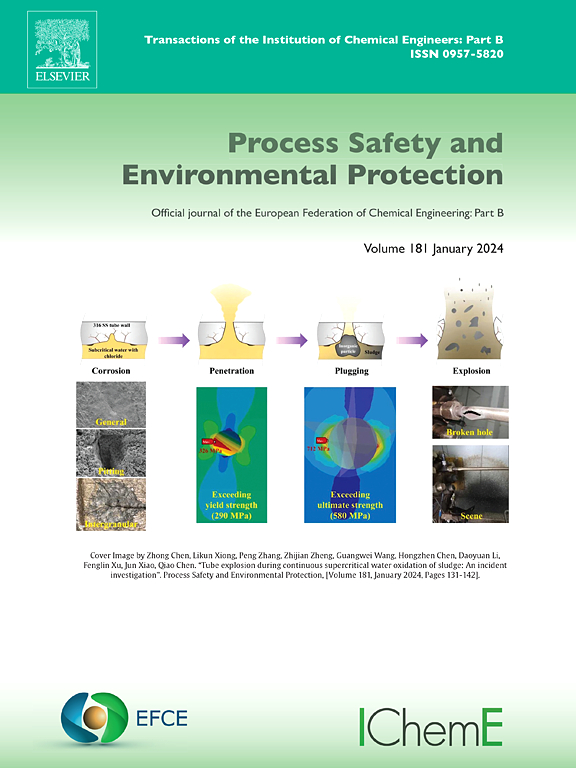合成酚类抗氧化剂(SPAs)在废水和大气中的反应规律及毒性效应的理论研究
IF 6.9
2区 环境科学与生态学
Q1 ENGINEERING, CHEMICAL
引用次数: 0
摘要
合成酚类抗氧化剂(SPAs)作为食品添加剂被广泛添加到油脂和油炸食品中。它们对人类和环境的危害不容忽视。采用密度泛函数(DFT)方法研究了超氧自由基(O2•-)、SO4•-、O3和•OH对三种SPAs (butyl hydroxyisoole (BHA)、二丁基羟基甲苯(BHT)和叔丁基对苯二酚(TBHQ))的降解机理。在大气中,TBHQ的•oh加成产物会与O2和NO反应,在废水中,TBHQ- oh中间体会与O2和HO2•反应生成产物。结果表明:废水体系中TBHQ与OH和O3加成反应的活化能(ΔG≠)分别为2.59 ~ 6.23 kcal/mol和10.29 ~ 20.35 kcal/mol,显著低于气相反应的活化能(4.91 ~ 9.74 kcal/mol和16.69 ~ 24.57 kcal/mol),液相降解效率较高。不同ROS对三种spa的降解速率常数依次为:•OH≈ SO4•- >; O3 >; >;O2•-。SPAs的半衰期t1/2(SO4•-)在273 ~ 313 K范围内为0.013 ~ 151.06 s, [SO4•-]为10−13 ~ 10−9 mol L−1。这三种spa在环境中很难持久存在。对于TBHQ,开环产物P2、P3、P4和P5的毒性显著低于TBHQ。基于SO4-的高级氧化工艺(AOPs)对spa的降解半衰期(t1/2)在273 ~ 313 K范围内为0.013 ~ 151.06 s,表明其具有高效的降解性能。有效降低了spa降解产物的毒性。该研究为基于SO4•-和•OH的高级氧化工艺(AOP)降解spa提供了理论支持。本文章由计算机程序翻译,如有差异,请以英文原文为准。
The reaction laws and toxicity effects of synthetic phenolic antioxidants (SPAs) in wastewater and atmosphere: A theoretical investigation
Synthetic phenolic antioxidants (SPAs) are widely added to fats and fried foods as food additives. Their hazards to humans and the environment cannot be ignored. The degradation mechanism of three SPAs (butyl hydroxyanisole (BHA), dibutyl hydroxytoluene (BHT) and tert-butyl hydroquinone (TBHQ)) by superoxide radical (O2•-), SO4•-, O3 and •OH is investigated using density functional theory (DFT) method. In the atmosphere, the •OH-addition products of TBHQ will react with O2 and NO, and in the wastewater, TBHQ-OH intermediates will react with O2 and HO2• to generate products. The results showed that the activation energies (ΔG≠) of the addition reactions of TBHQ with OH and O3 in wastewater systems were 2.59–6.23 kcal/mol and 10.29–20.35 kcal/mol, respectively, which were significantly lower than those of the gas-phase reactions (4.91–9.74 kcal/mol and 16.69–24.57 kcal/mol), indicating the high efficiency of liquid-phase degradation. The rate constants for the degradation of the three SPAs by different ROS are in the following order: •OH ≈ SO4•- > O3 > > O2•-. The half-life t1/2(SO4•-) of SPAs is 0.013–151.06 s in the range of 273–313 K and [SO4•-] of 10−13 to 10−9 mol L−1. These three SPAs are hardly persistent in the environment. As for TBHQ, the toxicity of the ring-opening products P2, P3, P4 and P5 was significantly lower relative to TBHQ. The degradation half-lives (t1/2) of SPAs by advanced oxidation processes (AOPs) based on SO4- in the range of 273–313 K were 0.013–151.06 s, indicating their efficient degradation properties.The toxicity of its degradation products of SPAs are effectively reduced. This work provides theoretical support for the degradation of SPAs by advanced oxidation processes (AOP) based on SO4•- and •OH.
求助全文
通过发布文献求助,成功后即可免费获取论文全文。
去求助
来源期刊

Process Safety and Environmental Protection
环境科学-工程:化工
CiteScore
11.40
自引率
15.40%
发文量
929
审稿时长
8.0 months
期刊介绍:
The Process Safety and Environmental Protection (PSEP) journal is a leading international publication that focuses on the publication of high-quality, original research papers in the field of engineering, specifically those related to the safety of industrial processes and environmental protection. The journal encourages submissions that present new developments in safety and environmental aspects, particularly those that show how research findings can be applied in process engineering design and practice.
PSEP is particularly interested in research that brings fresh perspectives to established engineering principles, identifies unsolved problems, or suggests directions for future research. The journal also values contributions that push the boundaries of traditional engineering and welcomes multidisciplinary papers.
PSEP's articles are abstracted and indexed by a range of databases and services, which helps to ensure that the journal's research is accessible and recognized in the academic and professional communities. These databases include ANTE, Chemical Abstracts, Chemical Hazards in Industry, Current Contents, Elsevier Engineering Information database, Pascal Francis, Web of Science, Scopus, Engineering Information Database EnCompass LIT (Elsevier), and INSPEC. This wide coverage facilitates the dissemination of the journal's content to a global audience interested in process safety and environmental engineering.
 求助内容:
求助内容: 应助结果提醒方式:
应助结果提醒方式:


